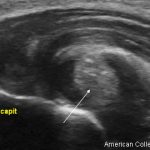We received several letters in response to the September 2011 “Ethics Forum,” which asked about the proper way to adopt ultrasound in your practice. We thank our respondents for their thoughtful and provocative comments. As many of you are aware, the ACR is currently drafting guidance for the use of musculoskeletal ultrasound. Perhaps we will rethink this topic once these are available.
A Question of Quality
We added ultrasound to our academic practice primarily because it is important for fellows to receive training in this imaging modality. For the aspiration/injection of joints such as the wrist, elbow, and ankle, real-time ultrasound guidance allows us greater accuracy in needle placement. For some small knee effusions, we are able to precisely place the injection in a way that would not otherwise be possible. Most patients who have had knee injections with and without ultrasound guidance much prefer that we use ultrasound because the injection is less painful. However, we do not use ultrasound when the clinician judges that it is not necessary.
In situations in which an assessment of synovial proliferation or inflammation is indeterminate by physical examination, ultrasound examination can allow us to more accurately assess the disease activity. It is also easy to identify bony erosions in the small joints of the hands with ultrasound.
In my opinion, the use of musculoskeletal ultrasound by rheumatologists is justified because it improves the quality of the care we provide. Obviously, performing ultrasound examinations solely for the purpose of generating revenue would be unethical. Our experience has been that the appropriate use of musculoskeletal ultrasound pays for the cost of the machine and produces some revenue.
Richard Brasington, MD
Professor of Medicine
Director of Clinical Rheumatology
Fellowship Program Director
Washington University in St. Louis School of Medicine
No Cash Cow, but a Good Tool
Before I considered purchasing an ultrasound machine, I took one online course and three hands-on courses. The best of these was the annual course offered by the American Institute for Ultrasound in Medicine (AIUM) at the Mayo Clinic. It took 100 hours of hands-on CME, countless hours of book work and online lectures, and at least 100 scans before I billed my first musculoskeletal ultrasound.
If you are conflicted about whether to purchase a machine because you are concerned that you will use it too much, I can reassure you that it is neither fast or convenient to become a sonographer—or to do a sonographic evaluation in the middle of a busy day. Studies show that it often takes three to four times as long to perform an injection under ultrasound. Reports must be carefully written and supported with images. Protocols for examinations are a must. However, I have found the technology a rewarding “problem solver.”
If you are concerned that you or your partners will not be “qualified” to do MSK ultrasound, then go to the AIUM web site and see what it takes to get accredited, which will almost certainly be required in the future. In 2012, there will be a national examination in MSK to become a certified sonographer. There are also some free sites (sonoworld.com) that can help introduce you.
Brian J. Keroack, MD
Rheumatology Associates
Portland, Maine
Training Is Needed
The colleague asks how she and her colleagues can be confident that they produce a quality ultrasound that benefits her patients, and justifies the cost. The ACR is investigating the option of offering a certification pathway for providers in rheumatology. If such a certification were available for rheumatologists and allied healthcare providers, passing an examination and obtaining certification could help ensure that quality care is provided.
Ralf Thiele, MD
Assistant Professor of Medicine
Department of Medicine
Allergy/Immunology and Rheumatology Division
University of Rochester School of Medicine and Dentistry


